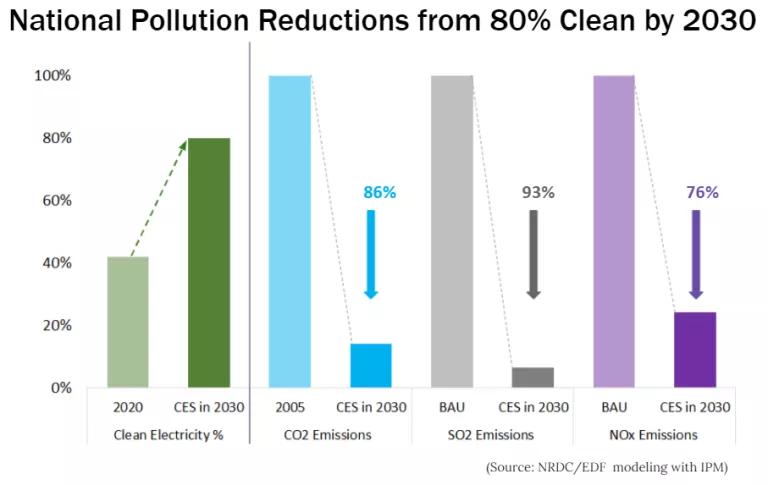80% Clean Power by 2030: Achievable with Massive Benefits
Rigorous analysis shows that reaching an 80 percent clean electricity sector by 2030 is achievable and will drive enormous climate, public health, and economic and job creation benefits that far exceed the investment cost.

This summer’s cascade of climate catastrophes—deadly heatwaves, fires, floods, and storms taking place on every continent—are telling our political leaders that there is no time to spare to deal with the climate emergency. President Biden has made climate action central to his Build Back Better agenda and to his American Jobs Plan. And the Senate budget committee’s budget resolution released this week included many major climate provisions that will make significant progress cutting pollution and building out clean energy, if passed.
A central part of President Biden’s proposal is cleaning up the nation’s electric power system, the second largest source of the carbon dioxide pollution driving the climate crisis. The president has proposed a target of achieving 80 percent clean electricity by 2030. Cutting power plant emissions on this scale will accomplish at least half of President Biden’s commitment to reduce America’s overall climate changing pollution by 50-52 percent by 2030. It will also put the nation on track to meet the president’s goal of a 100 percent clean electric system by 2035.
Rigorous analysis, summarized in this blog, shows that reaching an 80 percent clean electricity sector by 2030 is achievable and will drive enormous climate, public health, and economic and job creation benefits that far exceed the investment cost.
The first opportunity to meet the 2030 target for 80 percent clean electricity is through the budget reconciliation legislation now under consideration in Congress. The Senate budget committee’s budget resolution released this week included a clean electricity payment program (CEPP) and federal clean energy incentives to meet this target.
On a parallel track, the president’s Environmental Protection Agency (EPA) has the responsibility under current law—the Clean Air Act—to set standards for CO2 emissions from coal and gas power plants, to replace a do-nothing Trump administration rule that was rejected by a January court decision.
A range of analyses shows that getting from 40 percent clean today to 80 percent by 2030 target is achievable through one pathway or the other, with massive environmental and health benefits that dwarf the costs.
80% Clean Electricity Delivers Massive Benefits
Several recent analyses have assessed the feasibility and cost of accelerating clean energy deployment by 2030. Across the board, modeling efforts have found that 80 percent by 2030 is achievable at a reasonable cost, leads to a rapid buildout of renewable energy, creates between 500,000 and millions of net new jobs per year, and drives enormous benefits from reductions in climate-warming emissions and other harmful pollution.
The table below summarizes key results from several analyses of clean energy standard (CES) proposals. The CEPP is an investment program to achieve the same results as a CES. Similar results could also be achieved through Clean Air Act standards, although they might not be needed if Congress adopts a CEPP that does the job.

Accelerating clean energy at this pace will result in enormous public health and climate benefits. Various policy designs that achieve 80 to 86 percent zero-emission electricity by 2030 would result in greater than 80 percent reduction in carbon dioxide emissions from 2005 levels, as well as 88-98 percent reduction in SO2 emissions and 71-91 percent reductions in NOx compared to business as usual.

These pollution reductions will reduce climate impacts and improve air quality. For example, the Clean Energy Futures study found that deploying clean electricity to achieve 100 percent clean by 2040 will lead to $1.8 trillion in climate and public health benefits and avoid more than 300,000 premature deaths. The health and climate benefits exceed the costs more than five times over. An even stronger policy that achieves 80 percent zero-emission electricity by 2030 would lead to even greater benefits. NRDC modeling found that the benefits of achieving the 80 percent target are 5 to 9 times greater than the costs in 2030.
Not only do the benefits outweigh the costs by a large margin, but federal policy can also protect households and businesses from costs that do exist. For example, the CEPP, could use federal dollars to cover the incremental costs of the clean electricity transition and keep electricity costs low for customers.
80% Clean Electricity Is Broadly Supported
Federal policy to achieve 80 percent clean electricity by 2030 and 100 percent by 2035 benefits from widespread public support. Across the country, 62 percent support a 100-percent-by-2035 CES, while only 30 percent oppose. And the appeal extends to every region of the nation—a majority in all 50 states and 429 of the 435 Congressional districts support federal action to achieve 100 percent clean electricity by 2035.
Numerous electric utilities are committing to cleaning up their portfolios on a similar timeline. For example, Xcel Energy has committed to an 80 percent reduction in carbon dioxide emissions by 2030, and Xcel Colorado is planning for 80 percent renewable by the same date. In April, 13 utilities called on the Biden administration to pass policies that achieve the 2030 timeline.
Clean Energy Delivers Massive Job Growth
Wind and solar jobs are already the country’s fastest growing employment category. Now is the moment to accelerate that growth. Achieving 80 percent clean electricity by 2030 will lead to a net increase of more than 500,000 net new jobs in 2030 according to analysis by Energy Innovation, and preliminary analysis from NRDC finds even greater job growth—millions of net new jobs in the next decade. Federal, state, and private sector safeguards can ensure that clean energy workers are paid family-supporting wages and benefits and have a safe and healthy work environment, while ensuring rapid deployment.
Reconciliation Legislation Should Include the CEPP and Other Supporting Provisions
Along with a clean electricity payments program (CEPP) that achieves 80 percent clean electricity by 2030, the reconciliation legislation needs to include these additional provisions:
- long-term full-value tax incentives for new clean energy projects,
- grant programs to accelerate clean energy deployment and retire polluting facilities,
- funding to address disparities in energy burden and reduce electricity costs for low-income households,
- investments in the transmission and distribution system,
- funding to target cumulative air pollution burdens that affect environmental justice communities, and
- comprehensive wage replacement and paycheck protection for impacted workers in the electricity sector.
Lawmakers and the administration should enact and implement these investments in a way that follows through on President Biden’s Justice40 Initiative.
Meanwhile, EPA should move forward to propose strengthened Clean Air Act standards to clean up the electricity system, taking into account what Congressional action will accomplish before finalizing those standards.
These Congressional and EPA actions need to progress now and in parallel, as this summer’s climate catastrophes show there’s no time left for U.S. action to address the climate crisis.



.jpgb339.jpg)